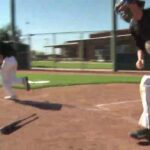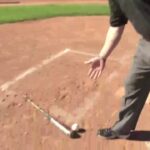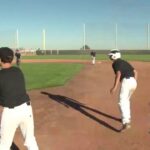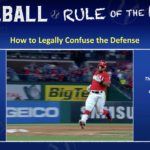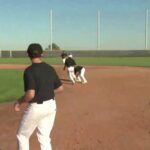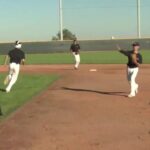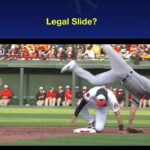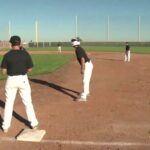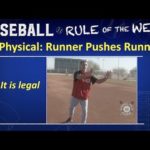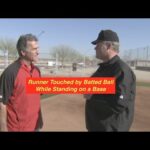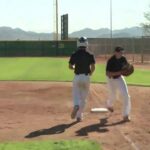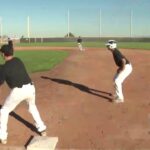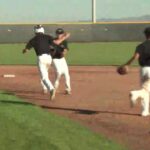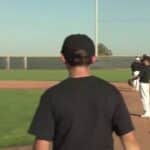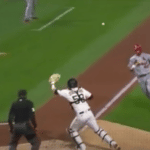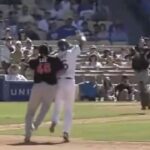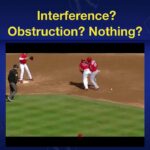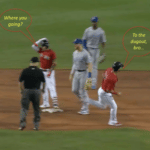NCAA 8-5 When Runners Are Out
When Runners Are Out
SECTION 5. A runner is out when:
a. In running to any base, while trying to avoid being tagged out, the runner runs more than three feet left or right from a direct line between the base and the runner’s location at the time a play is being made;
Exception—It is not an infraction if a fielder attempting to field a batted ball is in the runner’s proper path and the runner runs behind the fielder to avoid interference.
b. After reaching first base safely, the runner leaves the baseline in an obvious move to continue an attempt to advance to the next base and is tagged;
c. Any runner after reaching a base safely who leaves the base path heading for his dugout or his defensive position, believing that there is no further play, if the umpire judges the act of the runner to be considered abandoning his efforts to run the bases. Even though an out is called, the ball remains in play in regard to any other runner (see Rule 2-1, Abandonment);
Note: This rule will also cover similar types of plays: 1) Less than two outs, score tied, last inning, runner on first, batter hits the ball out of the park for the winning run. The runner on first touches second and believing the home run automatically wins the game, cuts across the diamond and heads toward his bench as the batter touches all the bases. In this example, the base runner would be called out for abandoning his effort to touch the next base. The batter-runner is permitted to continue around the bases to make his home run valid. If there were two outs, the home run would not count. This is not an appeal play. 2) A runner believing he is called out on a tag at first or third base starts for the dugout and progresses a reasonable distance still indicating by his actions that he is out, shall be declared out for abandoning the bases.
d. The runner interferes intentionally with a throw or thrown ball, or interferes with a fielder who is attempting to field a batted ball. If a double play is likely, and the runner intentionally interferes with the fielder who is attempting to field or throw the ball, both runner and batter-runner shall be declared out; Note 1: If two fielders attempt to field a batted ball, the umpire shall determine which fielder is more likely to make the play and only that fielder is protected from interference by the runner. Note 2: If a batted ball is deflected by the pitcher and another fielder has a legitimate play to retire a runner, the fielder is protected and contact by a base runner results in interference.
e. If the batter-runner interferes intentionally or unintentionally with a batted ball or the fielder fielding it, with a double play likely, the batter-runner and the runner closest to home plate are out, regardless of where the double-play attempt may have taken place;
f. A coach, by touching or holding a runner, physically assists the runner in returning to or leaving a base (see 3-3-e);
g. While third base is occupied, the coach stationed near that base runs in the direction of home plate on or near the base line while a fielder is making or trying to make a play and thereby draws a throw to home plate. The base runner on third shall be declared out for the coach’s interference with or prevention of the legitimate play (see 3-3-f);
h. One or more members of the offensive team stand at or around a base for which a base runner is trying, thereby confusing the defensive team. The base runner shall be declared out.
i. The individual is touched by the ball (when not dead) securely held in the hand or glove of a fielder while the runner is not touching the base;
Note: A ball stuck in a fielder’s glove remains alive. If the fielder tosses the ball/ glove combination to another fielder in time to complete a tag of a base or runner in advance of the base and the ball/glove combination is held securely, the runner or batter-runner is out.
Exception—If a batter-runner safely touches first base and then overslides or overruns it, the player immediately may return to first base without liability of being tagged out, provided no attempt to run to second was made. Also, if any base comes loose from its fastening when any runner contacts it, such a runner cannot be tagged out because the base slides away (see 8-3-q).
j. The individual fails to reach the next base before a fielder tags the runner or the base after the runner has been forced to advance because the batter became a runner;
Exception—No runner can be forced out if a runner who follows in the batting order is put out first. However, if a runner is put out during live action, it does not remove the force on any runners who might subsequently be declared out for a running infraction.
Note 1: No run may score on any play when the third out is either a force out or the result of a batter-runner’s failure to reach first base safely.
Note 2: The force is removed as soon as the base runner touches the base to which the runner is forced to advance; and if the runner overslides or overruns the base, the runner may be tagged out.
Note 3: If a runner tags the base to which the runner is forced and for some reason retreats toward the previous base, the runner is again subject to a force out.
k. The runner, including a runner in contact with a base, is hit while in fair territory by a fair batted ball before it has touched a fielder including the pitcher or passed all infielders who have a chance to make a play on the ball, other than the pitcher. If two runners are hit by the same fair ball, only the first runner is out (see 6-2-e).
Note 1: A runner who is touching a base when hit by an infield fly (see Rule 2— Infield Fly), is not out. If the runner is off a base and hit by an infield fly, both the runner and the batter are out; the ball is dead.
Note 2: A runner who, while touching a base, interferes with the fielder attempting to field a batted ball, is not out unless the umpire rules intentional interference. In this case, the batter is out if there are two outs. If there are less than two outs, both the batter and runner are out.
l. The individual attempts to score when the batter interferes with the play at home plate provided two are not already out. If two are out, the batter is out because of the interference and the runner does not score;
m. The individual passes an unobstructed preceding runner before such runner is out. The ball is live;
Note: With fewer than two outs, if a batter, while running the bases after a home run outside the playing field, passes a preceding runner, the batter is out; but all preceding runners score. With two outs, only those preceding runners score who have touched the plate before the batter is declared out. This is a time play, not an appeal play.
n. The individual runs bases in reverse order to confuse opponents or to make a travesty of the game;
PENALTY for n.—The ball is dead and other runner(s) return to the base last touched.
o. A batter-runner throws the bat, which interferes with a defensive player making a play (see 7-11-n);
p. A batter or any other runner who just has been put out interferes with a play being made on said runner; or
q. Any member of the offensive team does not vacate any live-ball area, thus interfering with a defensive player attempting to field a batted or thrown ball. This includes the batter, once the pitch has crossed the plate.
PENALTIES for q.—(1) With fewer than two outs, the runner is out if there is a play at the plate, and any other runners return to the base occupied at the time of the interference. 2) If there are two outs, the batter is out.
r. The runner deliberately knocks the ball from the fielder’s hand. The ball is immediately dead.




